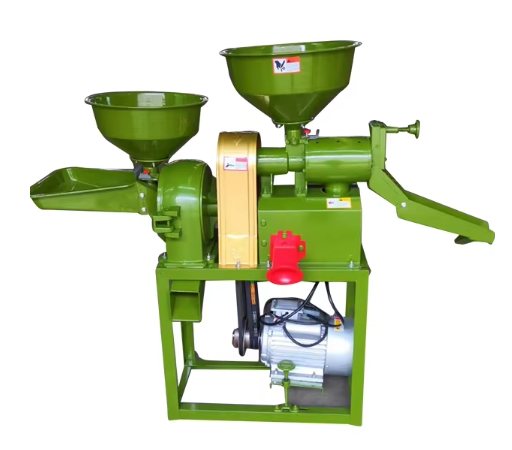पशु पोषणावर आहार प्रक्रिया उपकरणांच्या प्रभावाचे समजून घेणे
पशु आहाराची गुणवत्ता पशुपालनाच्या आरोग्य, वाढ आणि उत्पादकतेवर मूलभूत परिणाम करते. प्रभावी आहार प्रक्रियेच्या केंद्रस्थानी पशु आहार असतो चक्की , एक महत्त्वाचे उपकरण जे सुधारित पचनक्षमता आणि पोषक घटकांच्या शोषणासाठी क сыच्या आकारात कच्चा माल रूपांतरित करते. आधुनिक शेती क्रियाकलापांना हे समजले आहे की योग्य आहार कणांचा आकार फक्त घटक तोडण्याबद्दल नाही – तर पोषण रूपांतरण क्षमता जास्तीत जास्त करणे आणि पशूंच्या कामगिरीत सुधारणा करणे याबद्दल आहे.
जेव्हा काच्या मटेरियल्स एनिमल फीड ग्राइंडरमधून प्रक्रिया केली जाते, तेव्हा प्राण्यांना आपल्या अन्नातून जास्तीत जास्त पोषण मूल्य मिळविण्यास सक्षम केले जाते. अन्न प्रक्रिया मधील ही तांत्रिक प्रगती लाईव्हस्टॉक उद्योगात क्रांती घडवून आणली आहे, ज्यामुळे अन्न कार्यक्षमता गुणांकात सुधारणा झाली आहे आणि शेतकऱ्यांना आणि अन्न उत्पादकांना चांगले आर्थिक परतावे मिळाले आहेत.

फीड पार्टिकल साइज कमी करण्याच्या मागील विज्ञान
इष्टतम पार्टिकल साइज वितरण
एनिमल फीड ग्राइंडरची प्रभावक्षमता विविध प्रजाती आणि आयुष्याच्या टप्प्यांसाठी आदर्श पार्टिकल साइज वितरण तयार करण्याच्या क्षमतेवर अवलंबून असते. उदाहरणार्थ, छोट्या प्राण्यांना सहज पचनासाठी सामान्यत: अधिक बारीक कण आवश्यक असतात, तर प्रौढ प्राणी जाड ग्राइंडिंग सहज सहन करू शकतात. आधुनिक ग्राइंडिंग उपकरणांची अचूकता याची खात्री करते की फीडचे कण एकसमान असतात, ज्यामुळे कळपातील किंवा गटातील प्राण्यांमध्ये निवडक अन्न घेण्याचे वर्तन टाळले जाते आणि सर्व प्राण्यांना समान पोषण मिळते.
संशोधनात असे दिसून आले आहे की, योग्य प्रकारे बारीक केलेल्या अन्नाच्या कणांमुळे पचनादरम्यान एन्झाइम्सच्या क्रियेसाठी सतहीचे क्षेत्र वाढते, ज्यामुळे पोषक घटकांचे अवशोषण सुधारते आणि अन्नाचा वाया जाणारा त्रास कमी होतो. कणांच्या आकाराचे अनुकूलीकरण हे आधुनिक पशुपोषण कार्यक्रमांचे महत्त्वाचे घटक बनले आहे.
द्रव्य प्रक्रिया कार्यक्षमता
आजच्या पशु अन्न बारीक करण्याच्या तंत्रज्ञानात विविध कच्च्या मालाच्या प्रक्रियेला अनुकूलन करणारी उन्नत सुविधा समाविष्ट आहेत. धान्ये आणि लेग्यूम्सपासून ते तंतूयुक्त पदार्थांपर्यंत, या यंत्रांना विविध घटकांची प्रक्रिया करता येते आणि निरंतर उत्पादन गुणवत्ता राखता येते. बारीक करण्याच्या प्रक्रियेची कार्यक्षमता अंतिम अन्न उत्पादनाच्या पोषण मूल्यावर थेट परिणाम करते, ज्यामुळे विशिष्ट उत्पादन गरजांशी जुळणारे साहित्य निवडणे आवश्यक आहे.
सुधारित पचनशक्ती आणि पोषक घटकांचे अवशोषण
सुधारित अन्न रूपांतरण दर
जेव्हा चारा योग्य प्रकारे दळला जातो, तेव्हा पचनादरम्यान प्राणी कमी ऊर्जा खर्च करतात, ज्यामुळे चारा रूपांतरण दरात सुधारणा होते. प्राण्यांचा चारा दळण्याचे उपकरण अशी कण तयार करते जी पाचक एंझाइम्ससह सहज मिसळली जाऊ शकतात, ज्यामुळे पोषक घटकांचे अधिक कार्यक्षम निष्कर्षण होते. ही सुधारित पचनक्षमता उत्पादकांसाठी चांगल्या वाढीच्या दरात आणि चाऱ्याच्या कमी खर्चात बदलते.
आदर्श प्रकारे दळलेल्या चाऱ्यामुळे चारा रूपांतरण कार्यक्षमतेत 15% पर्यंत सुधारणा होऊ शकते, ज्यामुळे व्यावसायिक ऑपरेशन्ससाठी मोठ्या प्रमाणात आर्थिक फायदे होतात. गुणवत्तापूर्ण दळण उपकरणांद्वारे साध्य केलेल्या एकसमान कणांच्या आकारमुळे प्रत्येक घासात प्राण्यांना एकसमान पोषण मिळते.
चयापचयाचे फायदे
पशू पोषण संशोधनात धुळीच्या आकाराचे चयापचय क्षमतेशी असलेले संबंध चांगल्या प्रकारे दस्तऐवजित केले गेले आहेत. योग्य प्रकारे दळलेले अन्न पचन संस्थेमध्ये आतड्याच्या कार्याला आणि फायदेशीर बॅक्टीरियल लोकसंख्येला पाठबळ देते. यामुळे प्रतिकारशक्तीची प्रतिक्रिया आणि एकूण पशू आरोग्य चांगले होते, ज्यामुळे औषधी हस्तक्षेपाची गरज कमी होते आणि टिकाऊ उत्पादन पद्धतींना पाठिंबा मिळतो.
दळण तंत्रज्ञानात गुंतवणुकीचे आर्थिक फायदे
ऑपरेशनल खर्च कमी करणे
गुणवत्तापूर्ण पशु अन्न दळण यंत्रात गुंतवणूक केल्याने सुधारित अन्न कार्यक्षमता आणि कचऱ्याच्या कमी होण्यामुळे मोठ्या प्रमाणात खर्चात बचत होऊ शकते. आधुनिक दळण उपकरणांमध्ये उच्च उत्पादन क्षमता राखताना ऊर्जा-कार्यक्षम डिझाइनचा समावेश असतो ज्यामुळे विजेचा वापर कमी होतो. धुळीच्या आकाराच्या कमी करण्याच्या अचूकतेमुळे कच्च्या मालाचे कमी अतिप्रक्रियाकरण आणि चांगले वापर होते.
तसेच, चांगल्या प्रकारे देखभाल केलेले ग्राइंडिंग साधन दुरुस्तीचा खर्च आणि बंदीचा कालावधी लक्षणीयरीत्या कमी करू शकते, ज्यामुळे पशुसंवर्धन ऑपरेशन्ससाठी निरंतर उत्पादन वेळापत्रके आणि विश्वासार्ह अन्न पुरवठा सुनिश्चित होतो.
उत्पादन वाढवण्याची क्षमता
लहान शेत ऑपरेशन्सपासून ते मोठ्या व्यावसायिक अन्न मिल्सपर्यंत विविध उत्पादन पातळ्यांना अनुकूल असण्यासाठी आधुनिक पशु अन्न ग्राइंडर प्रणाली डिझाइन केल्या आहेत. ग्राइंडिंग पॅरामीटर्समध्ये बदल करण्याची लवचिकता उत्पादकांना विशिष्ट ग्राहक आवश्यकता पूर्ण करण्यास आणि बदलत्या बाजाराच्या मागणीला अनुकूल होण्यास अनुमती देते. ही वाढवण्याची क्षमता सुनिश्चित करते की ऑपरेशन्स वाढत आणि विकसित होत असताना ग्राइंडिंग तंत्रज्ञानातील गुंतवणूक मूल्य देणे सुरू ठेवू शकते.
वारंवार विचारले जाणारे प्रश्न
पशु अन्नासाठी आदर्श कण आकार ठरवण्यासाठी कोणते घटक जबाबदार असतात?
आदर्श कण आकार हा प्राण्याच्या प्रजाती, वय, उत्पादन टप्पा आणि वापरल्या जाणार्या अन्न साहित्याच्या प्रकार यासह अनेक घटकांवर अवलंबून असतो. उदाहरणार्थ, कोंबड्यांना सामान्यतः मोठ्या प्रमाणात खुरपलेल्या कणांची गरज असते, तर तरुण प्राण्यांना प्रौढांपेक्षा बारीक खुरपणे आवश्यक असते. प्राण्यांच्या अन्न खुरपणीसाठी यंत्र समायोजित करता येणारे असावे जेणेकरून या विविध गरजा पूर्ण होतील.
खुरपणे अन्न मिश्रण आणि गोळे बनवण्याच्या प्रक्रियेवर कसा परिणाम करते?
अन्न मिश्रण आणि गोलाकारीकरणासाठी योग्य खुरपणे अत्यंत आवश्यक आहे. एकसमान कण आकार मिश्रणादरम्यान घटकांच्या चांगल्या मिश्रणासुन खात्री करतो आणि प्रक्रियेदरम्यान चांगल्या दर्जाच्या गोलाकार अन्नाची निर्मिती होते. चांगल्या प्रकारे खुरपलेल्या सामग्रीला गोलाकारीकरणादरम्यान कमी ऊर्जेची गरज असते आणि अधिक टिकाऊ अंतिम उत्पादने मिळतात.
उत्तम खुरपणी यंत्राच्या कार्यक्षमतेसाठी कोणती देखभाल आवश्यक आहे?
पशु आहार ग्राइंडरच्या नियमित देखभालीमध्ये स्क्रीन आणि हॅमरची तपासणी, बेअरिंग चर्बी लावणे आणि घिसटणाऱ्या भागांचे निरीक्षण करणे याचा समावेश होतो. योग्य देखभाल वेळापत्रक खात्री करतात की कणांचा आकार सुसंगत राहतो, ऊर्जा कार्यक्षमता इष्टतम राहते आणि उपकरणांचे आयुष्य वाढते. देखभालीच्या अंतराळासाठी आणि घिसटणाऱ्या घटकांच्या प्रतिस्थापनासाठी उत्पादकाच्या मार्गदर्शक तत्त्वांचे अनुसरण करणे शिफारसीय आहे.

